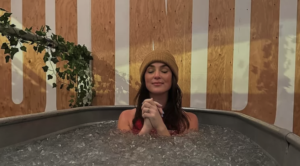Contrast therapy, also known as hot and cold therapy or contrast bath therapy, is a recovery technique that involves alternating exposure to hot and cold temperatures. This is typically done by immersing the body or a specific body part in hot water, followed by immediate immersion in cold water, and repeating this cycle several times.
How it Works:
Contrast therapy leverages the body’s natural responses to heat and cold to achieve its therapeutic effects.
Heat Therapy (Thermotherapy):
Vasodilation: Heat causes blood vessels to dilate (widen), increasing blood flow to the area. This brings oxygen and nutrients to promote healing and flushes out metabolic waste products.
Muscle Relaxation: Heat helps relax muscles, reducing tension and spasms.
Pain Relief: Increased blood flow can help reduce pain signals.
Cold Therapy (Cryotherapy):
Vasoconstriction: Cold causes blood vessels to constrict (narrow), reducing blood flow and inflammation.
Numbs Pain: Cold can numb nerve endings, providing pain relief.
Reduces Swelling: Vasoconstriction helps limit swelling and inflammation.
The Contrast:
The alternating hot and cold immersions create a “pumping” action in the blood vessels. This vascular flushing is believed to:
Enhance Circulation: Improves blood flow and lymphatic drainage, aiding in the removal of waste products and delivery of nutrients.
Reduce Inflammation: Limits swelling and inflammation by constricting blood vessels.
Speed Up Recovery: Accelerates the healing process by increasing circulation and reducing inflammation.
Methods of Application:
Immersion Baths: The most common method involves alternating between hot and cold water baths. This can be done with the whole body or just a specific limb or body part.
Hot and Cold Packs: Alternating between hot packs (e.g., hot water bottles, heating pads) and cold packs (e.g., ice packs, gel packs) applied to the affected area.
Sauna and Cold Plunge: Alternating between sessions in a sauna and a cold plunge pool. This is becoming increasingly popular in wellness and recovery centers.
Benefits:
Reduces Muscle Soreness and Fatigue: Helps alleviate delayed-onset muscle soreness (DOMS) after intense exercise.
Decreases Inflammation and Swelling: Beneficial for sprains, strains, and other inflammatory conditions.
Improves Range of Motion: Can help increase flexibility and joint mobility.
Enhances Recovery: Aids in recovery from sports injuries and surgeries.
May Reduce Pain: Provides temporary pain relief from conditions like arthritis and tendonitis.
Potential Psychological Benefits: Some people find contrast therapy invigorating and mentally stimulating.
Applications:
Sports Medicine: Widely used by athletes to recover from training and competitions.
Physical Therapy: Used in rehabilitation programs for various injuries and conditions.
Post-Surgery Recovery: Helps reduce swelling and pain after surgery.
Arthritis Management: May provide temporary relief from arthritis pain and stiffness.
General Wellness: Used to promote relaxation, circulation, and overall well-being.
Precautions and Contraindications:
Consult Your Doctor: Always consult your doctor before starting contrast therapy, especially if you have any underlying health conditions.
Cardiovascular Issues: People with heart conditions or circulatory problems should use caution.
Sensory Impairment: Individuals with reduced sensation may not be able to accurately gauge water temperature.
Open Wounds: Avoid contrast therapy on open wounds or skin infections.
Pregnancy: Pregnant women should consult their doctor before using contrast therapy.
Typical Protocol:
Warm Water: 3-4 minutes in water at 100-104°F (38-40°C)
Cold Water: 1 minute in water at 50-64°F (10-18°C)
Repeat: 3-4 cycles, ending with cold water.
Key Takeaways:
Contrast therapy is a safe and effective recovery modality for many people. By harnessing the power of hot and cold, it can help reduce inflammation, enhance circulation, and speed up the healing process. However, it’s crucial to follow proper guidelines and consult with your doctor if you have any concerns.

Contrast therapy Houston
Route
Calisthenics Gym Houston Functional Bodyweight Training
Secondary phone: (346) 483-3195
Email: info@calisthenicsclubhouston.com
URL: https://calisthenicsclubhouston.com/
Monday 6:00 AM - 7:00 PM Tuesday 6:00 AM - 7:00 PM Wednesday 6:00 AM - 7:00 PM Thursday 6:00 AM - 7:00 PM Friday 12:00 PM - 6:30 PM Saturday 9:45 AM - 12:00 PM Sunday 3:00 PM - 5:00 PM





